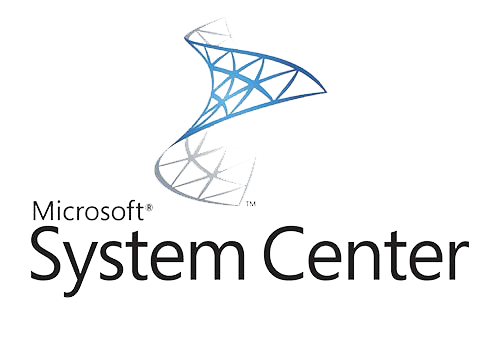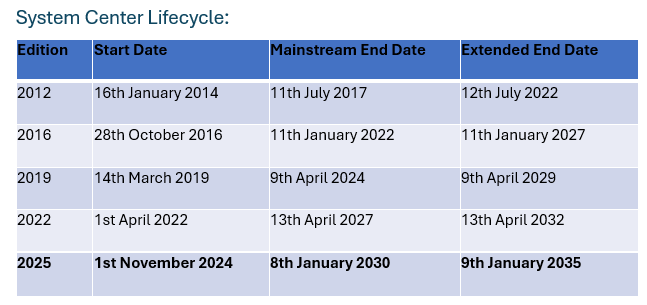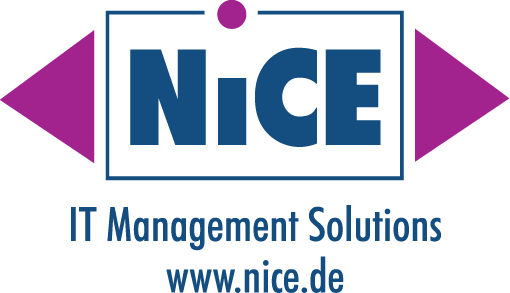Microsoft System Center Products and Services
Microsoft System Center is a suite of software tools designed to help you manage both on-premises and cloud-based IT infrastructure. It includes multiple products and services that allow you to manage your IT infrastructure effectively, including:
-
- Automation via Orchestrator (SCORCH) for integration and orchestration
- Monitoring and Reporting via Operations Manager (SCOM) for alert monitoring
- Device Management via Configuration Manager (SCCM) for patching and deployment
- VM Management and Provisioning via Virtual Machine Manager (VMM) for Hyper-V and VMware
- Backup via Data Protection Manager (DPM) for application, file systems, and VM backup
- ITSM via Service Manager (SCSM) for Service Desk and CMDB
All these tools are designed to work independently or together to provide a consistent method to manage both on-premises and cloud-based resources, as well as hybrid environments.

System Center Releases
Microsoft System Center 2025 is the latest release of the System Center Suite, and it offers several new features and enhancements, including access to Azure management services with Azure Arc to make hybrid management easier, enhanced VMware to Hyper-V VM conversion, and additional security.
Kelverion has been providing Integration Packs and Solutions for Orchestrator and consulting services around System Center since 2010. Our Team has detailed experience with Orchestrator, Configuration Manager, Operations Manager, and Virtual Machine Manager, plus contacts with experts in Data Protection Manager and Service Manager.
Whatever your System Center needs we can help.

Monitoring & Automation: Better Together
SCOM + SCORCH: Monitoring That Works While You Sleep
Monitoring tells you what’s happening—automation helps you do something about it.
By combining Microsoft System Center Operations Manager (SCOM) with System Center Orchestrator (SCORCH), you unlock the power of self-healing infrastructure and automated incident response.
Harness the full potential of Microsoft System Center Operations Manager (SCOM) with industry-leading NiCE Management Packs and expert guidance from our team.
Our close partners NiCE produces Management Packs that extend SCOM’s native capabilities, giving you deep, actionable insights into mission-critical technologies:
- NiCE Active 365 MP – Monitor Microsoft 365 assets
- NiCE VMware MP – Deep VMware vSphere environment management
- NiCE NetApp MP – Application-level insight for NetApp environments
- NICE Entra Connect MP – Monitor the identity synchronization health
- NiCE Linux/Unix MP – Rich monitoring beyond Windows
- …and many more
All NiCE MPs are optimized for performance, ease of use, and seamless SCOM integration.
Integrated System Center Use Cases
Often, organizations think of System Center as individual products, but they are much more powerful when working together.
Service Desk Incident Ticket Creation, Routing, Diagnostics, and Remediation for Server Alerts
Orchestrator and Operations Manager in unison
A large insurance provider uses Operations Manager (SCOM) to manage 6,000+ servers, VMware VM’s, SQL Servers, and Oracle Database Servers. They use ServiceNow for Incident Management with 24 support Groups and generate 400-500 tickets per week.
Orchestrator is used for end-to-end Ticket Management between SCOM and ServiceNow:
-
- Orchestrator detects all New Alerts in SCOM
- Orchestrator determines if they need to have a ticket raised
- If an existing ticket is open, Orchestrator updates the ticket
- If no ticket already exists, Orchestrator determines the resolver group and raises the ticket directly to the support group
- When the Ticket is resolved in ServiceNow, Orchestrator goes back to close the SCOM alert…OR when it detects the alert closes in SCOM, Orchestrator will resolve the ticket in ServiceNow.
This saves the company at least 1.5 Full-time Employees per month over doing this process manually
Self-Service VM Provisioning
Service Request Portal, Orchestrator, Virtual Machine Manager, Operation Manager, and Configuration Manager working together
-
- In a Service Request Portal, a User raises a VM Provision Request.
- Orchestrator picks up the New Provision Request and creates a Change Request in the Service Desk with the Request information entered in the original portal submission.
- Working with Virtual Machine Manager, Orchestrator checks available Capacity and allocates an IP Address and Hostname.
- It then initiates the VM Provision in Virtual Machine Manager.
- Next, Orchestrator updates the Change Request in the Service Desk with the Hostname, IP Address, and VM details and creates a new CI record for the VM.
- Orchestrator then adds the New Server to the appropriate Collections, and the Software gets deployed via Configuration Manager (SCCM).
- Then, Orchestrator instructs Operations Manager (SCOM) to push its Agent onto the New Server so it becomes under management.
- Finally, Orchestrator updates/closes the Change Request in the Service Desk as well as updates the original Service Request in the Portal with all the VM Details (closing the loop).
This process is completed within one day with automation, where it could take almost a week to complete manually.

